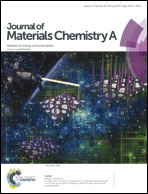Non-ultraviolet photocatalytic kinetics of NaYF4:Yb,Tm@TiO2/Ag core@comby shell nanostructures†
Abstract
An effective near-infrared (NIR) active photocatalyst, NaYF4:Yb,Tm@TiO2/Ag (UC@TiO2/Ag) core@comby shell composite, was synthesized by a simple three-step hydrothermal process. Under the full-spectrum light of a Xe lamp in UV-Vis absorbance experiments, about 96% of R6G dyes in solution were degraded by UC@TiO2/Ag in 120 minutes, while only about 64% of the dyes were degraded by pure TiO2 under the same conditions. Under a UV-filtered Xe lamp, about 35% of the dyes were degraded by UC@TiO2/Ag in 120 minutes; interestingly, only about 8% of the dyes were degraded by pure TiO2. Under irradiation by a 785 nm laser in surface enhanced Raman scattering (SERS) experiments, the photodegradation rate constants were 0.02612 s−1 for UC@TiO2/Ag and 0.00046 s−1 for TiO2/Ag, indicating a nearly 58 fold improvement. After deducting the photobleaching effect, the photodegradation rate constants for UC@TiO2/Ag under 633 and 532 nm lasers were 0.00715 s−1 and 0.00565 s−1, respectively, revealing a sharp decrease under irradiation at shorter wavelengths. Electron spin resonance (ESR) analysis revealed that the presence of UC in this photocatalytic system certainly induced the increase of ˙OH free radicals with NIR irradiation, i.e. the UC core converts NIR light into ultraviolet (UV) light and initiates excellent photocatalytic activity of the TiO2/Ag comby shell. Furthermore, the decorating of Ag nanoparticles not only enhances the photocatalytic ability, but also provides a structural basis for monitoring the photocatalytic kinetics by the SERS technique. By virtue of monochrome laser lines, SERS analysis provides direct evidence to prove the capability of UC-initiated non-UV photocatalysis and the improvement of the utilization of non-UV lights on TiO2. The results revealed that this new photocatalytic platform can efficiently utilize different bands of the solar spectrum and also find new applications in SERS fields.


 Please wait while we load your content...
Please wait while we load your content...